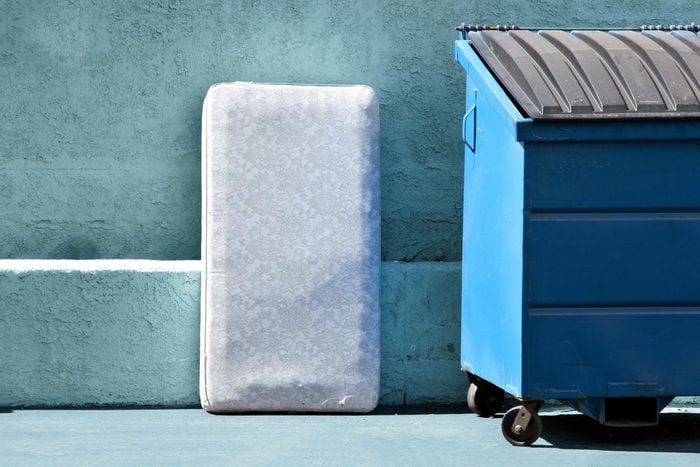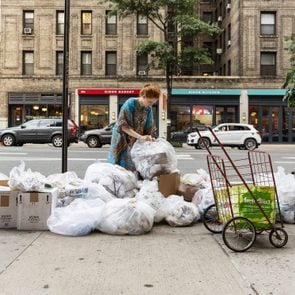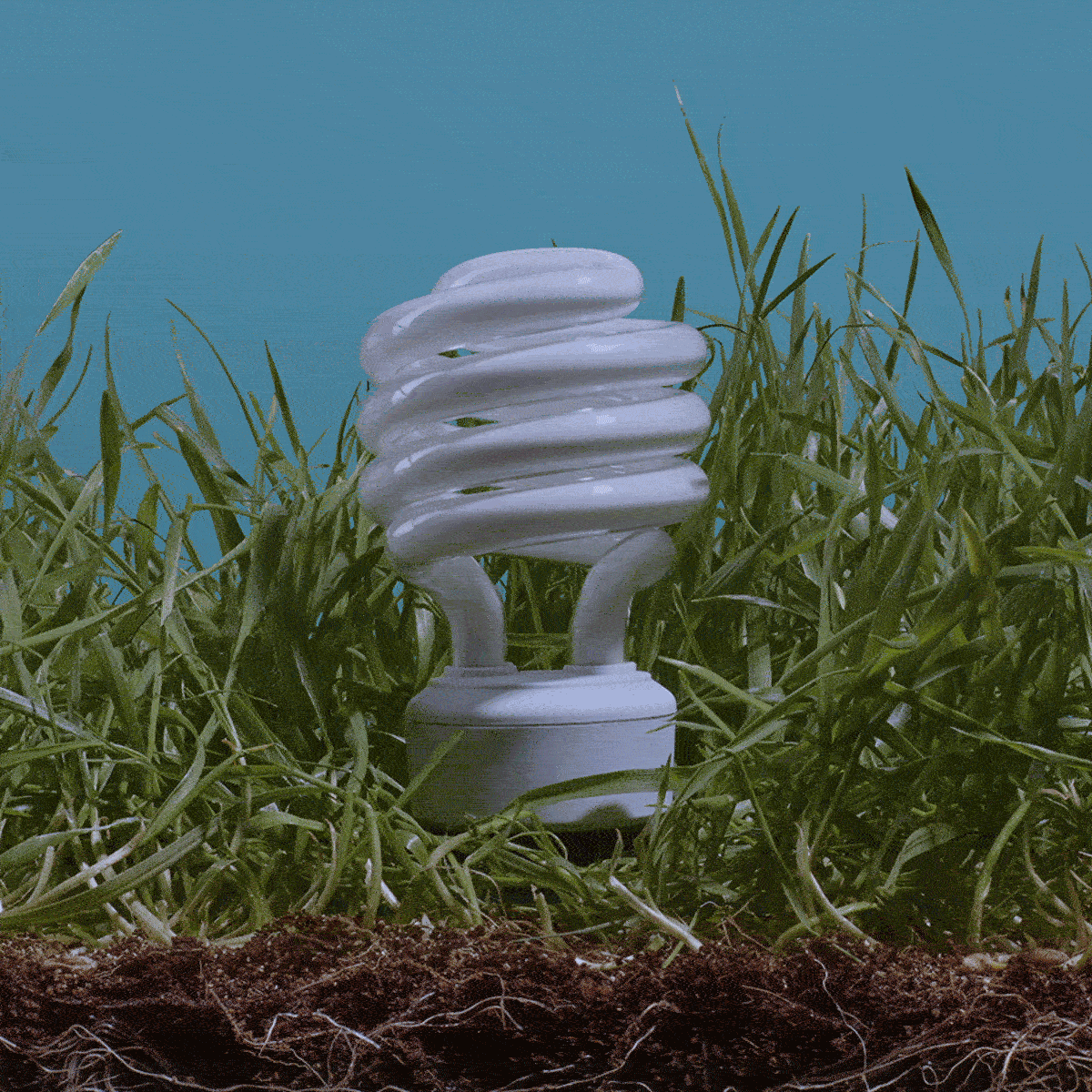How to Recycle Your Old Mattress: 6 Easy Options
Updated: Feb. 01, 2024

Dreaming of getting a new bed? Before you do, read up on mattress recycling to upgrade without harming the planet.
A mattress is meant to last anywhere from 15 to 20 years, so ditching your old one isn’t all that wasteful, right? Surprisingly, wrong. Each year, Americans purchase around 39.5 million mattresses, according to market research company Statista, and we’re on track to skyrocket the mattress industry to $43 billion by 2024. But the big problem is the environmental impact. Cascade Alliance, which works with nonprofits on projects such as mattress recycling, estimates that we throw out 20 million mattresses and box springs every year, the majority of which end up in landfills or incinerators.
To add insult to injury, mattress recycling is relatively easy, so millions of old mattresses end up polluting the planet for no good reason. Recyclable items ending up in a landfill? That’s certainly not the right way to recycle. And it’s the antithesis of sustainable living.
Suffice to say, we have a lot to learn about how to properly take care of our stuff, from how to clean a mattress to how to recycle anything. That’s why Reader’s Digest consulted a recycling expert to get to the bottom of mattress recycling. Before you invest in one of the best mattresses on the market, find out how to recycle your old mattress and get insight into how mattress recycling works.
Can you recycle mattresses?
When we think of recycling, mattresses probably aren’t the first things that come to mind. You can’t shove one in your little recycling bin, after all. And while no mattresses are fully biodegradable, they are indeed recyclable.
In fact, about 80% of materials in the average mattress can be recycled. That’s because most are made of steel springs, a wood frame, polyurethane foam and fabric. Pretty much all mattress types are fair game, from traditional innerspring mattresses to latex, hybrid and memory foam options. And yes, you can recycle nontoxic mattresses and organic mattresses too.
The only kind of mattress that shouldn’t be recycled is a dirty one. “If your mattress has mold or bed bugs, we ask that you do not recycle your mattress, as it can be a health risk to mattress recycling employees,” says Marti Matsch, deputy director of Eco-Cycle, a nonprofit recycling and zero-waste organization.
The process starts with the fabric, which a recycling facility will typically cut open to reveal more recyclable materials inside. “If your community offers a hard-to-recycle facility, you may be able to recycle your mattress and box springs,” Matsch says. “For example, in Boulder County, you can recycle your mattress at the Eco-Cycle Center for Hard-to-Recycle Materials.”
The metal springs inside of a mattress are usually resold as scrap metal, which can go on to become pretty much anything, as metal is highly recyclable. Wood from the frame can be broken down into wood chips or mulch, and the mattress’s foam and fabric can be used for anything from carpet pads and animal beds to insulation, yarn and other textiles.
But not all parts of a bed are recyclable. At most mattress recycling sites, you’ll have a hard time recycling items like pillows, mattress pads, water beds without upholstery material and camping air mattresses.
That said, Eco-Cycle’s Center for Hard-to-Recycle Materials (aka CHARM) is a bit more flexible, proof that doing your research pays. A little digging will help you determine which recycling services are available to you locally.
Is it beneficial to recycle mattresses?
Mattresses are big and bulky, and when they get sent to a landfill, they take up a lot of space unnecessarily—all while contributing to greenhouse gas emissions and posing hazards to the environment. So yes, mattress recycling is a better option, and there are countless benefits to the process that go beyond easing your climate anxiety.
Not only does recycling a mattress keep it out of a landfill, but it also reduces the need for raw materials used to make new mattresses and other products. That’s good news for our planet.
“You’re also contributing to the creation of local jobs, as each mattress is broken down by hand by employees,” Matsch explains. “Eco-Cycle partners with Spring Back Colorado for mattress recycling; we collect the mattresses at the Eco-Cycle CHARM and then transfer the mattresses to Spring Back Colorado, which employs the disenfranchised and those with barriers to employment.”
How do you recycle mattresses?
Now that you know mattress recycling is a viable (and sustainable) option, you may be wondering how to go about it. There are a few ways to recycle an old mattress—we list six easy options below—but the most important thing is to make sure it’s not just sent to a landfill. “Ask the recycler what happens to the mattress to ensure it is being recycled and not ‘disposed of,'” Matsch suggests.
Each different material from the mattress can be recycled and used to make other things. Certified mattress recycling programs can cut up the foam from mattresses and make it into carpet padding, foam inserts used for gymnastics mats and even roofing material.
Use a mattress recycling program
A meaningful place to start is by researching mattress recycling programs local to your area. Make sure you’re looking for recycling centers (the key word being “recycling”), not merely garbage disposal services. With the latter, your mattress will end up at the landfill.
Look for local recycling spots, and maybe even call the center’s headquarters to see if it specifically takes mattresses.
You can certainly do some googling, but an even easier way to find local resources is to check Earth 911 and Bye Bye Mattress. Head to Earth 911’s site to find nearby services and facilities—just type “mattress” into the search bar along with your ZIP code. Or try Bye Bye Mattress, a recycling service available in California, Connecticut and Rhode Island; even if you live out of state, you can browse a list of mattress recycling facilities across the country.
“Since these resources are self-populated by the listed companies, the list may not be comprehensive if participating businesses did not add their services to the list, so we advise you to also do an internet search in your area,” Matsch says.
St. Vincent de Paul is another go-to mattress recycling program. It employs ex-convicts and people with other barriers to work, offering compensation above minimum wage and health benefits. Once a mattress reaches St. Vincent de Paul’s program, workers break it down and upcycle the covers into dividers for shelter housing. The nonprofit sends additional materials to the appropriate recycling locations.
Call the mattress manufacturer
It may surprise you to learn that some mattress manufacturers, such as Saatva and Nolah, will actually take your old mattress off your hands.
“When delivering your new mattress, some companies will haul away your old one,” Matsch says. “But do not assume that they are recycling your old mattress. Please check with the company to find out if your mattress is being recycled, and to know it is being recycled, ask specific questions about what it’s recycled into.”
If the manufacturer can’t answer your questions, there’s a chance your old mattress is headed for a landfill. But that’s not always the case. Some manufacturers donate old mattresses instead, sending them to places like the Salvation Army or homeless shelters.
Donate it
Donating your old mattress is perhaps even more beneficial than recycling it. When you donate a mattress, you’re prolonging its life and helping out someone in need.
“Reuse through donating to charities is always the most sustainable way to handle your mattress—or other unwanted items,” Matsch says. “If you are able to donate your clean and reusable mattress, that is always preferable to recycling it.”
But know that your mattress may not be a candidate for donation if it has a lot of obvious signs of wear. And again, a mattress should never be donated if it has mold or bed bugs.
Not sure where to donate? Companies that most often take mattress donations include the Furniture Bank Association of America, Salvation Army, Habitat for Humanity, Goodwill and Donation Town. You can also check out your local thrift store and/or church to see if they accept mattress donations.
Before you drop off your old mattress, do some research. In some states, donating a used mattress is illegal, so first do a thorough search for local enforcement.
Schedule home pickup
Depending on where you live, there may be at-home pickup services that you can schedule. Companies like LoadUp, 1-800-Got-Junk, College Hunks Hauling Junk and Moving, and the veteran-owned JDog Junk Removal and Hauling have been known to pick up mattresses directly from homes and transport them to the appropriate recycling center.
But as Matsch suggests, you may want to ask a few questions first to ensure your mattress is being recycled and not discarded.
Upcycle old mattress parts
Whether you’re feeling super creative or are just a handy person (or know a handy person), upcycling is always an option—no matter what the item is. But how exactly do you upcycle a mattress? Admittedly, it takes a bit more work than upcycling clothes.
Start by looking at your mattress through the lens of its raw materials.
“If a mattress recycler is not available in your area, a handy person using tools can safely pull a box spring apart and recover the scrap metal coils, which will be recyclable in almost any community, as scrap metal is a valuable and common recyclable,” Matsch says. “A crafty person might tear open a mattress to recover the foam and sew a new covering over it to make floor cushions or pet bedding.”
Here are a few fun ideas for what to do with each mattress part, if you go the route of upcycling:
-
Fabric: Make floor cushions, pillows, clothes and rugs.
-
Foam: Use it for pet bedding, cushions, pillows, stuffed animal stuffing and packaging for mailers.
-
Steel coils: Craft them into a wine rack, fencing, shelving, mug rack, headboard or garden trellis.
-
Wood frame: Repurpose it into firewood, mulch, raised garden beds, planters, a compost bin or fence posts.
Sell it
While it’s probably a long shot, you may be able to sell your mattress, provided it’s spectacularly clean, in excellent condition and without obvious signs of use. Try resale platforms like Craigslist and Facebook Marketplace to start.
Finding out where to sell unwanted stuff is one of the most effective repurposing options for a mattress. Like donating, reselling your mattress increases its longevity and delays its trip to a landfill or recycling center.
Living sustainably
With your old mattress recycled and on its way to becoming something new, it’s time to turn your gaze to other ways you can live a more sustainable life. You don’t have to live a life without plastic to make a difference. Even with small steps, like recycling old clothes and packing material, the future of recycling is bright.
Sources:
- Marti Matsch, deputy director of Eco-Cycle
- Statista: “Mattress Retail in the U.S. – Statistics & Facts”
- Cascade Alliance: “The State of the Mattress Recycling Industry”
- Mattress Advisor: “Mattress Recycling and the Products Made from Recycled Mattresses”



